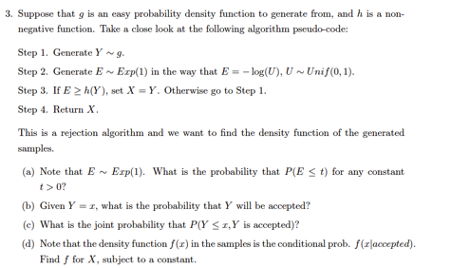Suppose that g is an easy probability density function to generate from, and h is a non- negative function. Take a close look at the following algorithm pseudo-code: Step 1. Generate Y ~g. Step 2. Generate E- Erp(1) in the way that E = - log(U), U ~ Unif(0, 1). Step 3. If E 2 k(Y), set X = Y. Otherwise go to Step 1. Step 4. Return X. This is a rejection algorithm and we want to find the density function of the generated samples. (a) Note that E- Exp(1). What is the probability that P(E < t) for any constant t> 0? (b) Given Y = 1, what is the probability that Y will be accepted? (e) What is the joint probability that P(Y <1,Y is accepted)? (d) Note that the density function f(z) in the samples is the conditional prob. f(r|accepted). Find f for X, subject to a constant.
Suppose that g is an easy probability density function to generate from, and h is a non- negative function. Take a close look at the following algorithm pseudo-code: Step 1. Generate Y ~g. Step 2. Generate E- Erp(1) in the way that E = - log(U), U ~ Unif(0, 1). Step 3. If E 2 k(Y), set X = Y. Otherwise go to Step 1. Step 4. Return X. This is a rejection algorithm and we want to find the density function of the generated samples. (a) Note that E- Exp(1). What is the probability that P(E < t) for any constant t> 0? (b) Given Y = 1, what is the probability that Y will be accepted? (e) What is the joint probability that P(Y <1,Y is accepted)? (d) Note that the density function f(z) in the samples is the conditional prob. f(r|accepted). Find f for X, subject to a constant.
A First Course in Probability (10th Edition)
10th Edition
ISBN:9780134753119
Author:Sheldon Ross
Publisher:Sheldon Ross
Chapter1: Combinatorial Analysis
Section: Chapter Questions
Problem 1.1P: a. How many different 7-place license plates are possible if the first 2 places are for letters and...
Related questions
Question
Pls help with (a), (b), (c), (d)

Transcribed Image Text:3. Suppose that g is an easy probability density function to generate from, and h is a non-
negative function. Take a close look at the following algorithm pseudo-code:
Step 1. Generate Y ~g.
Step 2. Generate E~ Erp(1) in the way that E = – log(U), U~ Unif(0, 1).
Step 3. If E 2 h(Y), set X = Y. Otherwise go to Step 1.
Step 4. Return X.
This is a rejection algorithm and we want to find the density function of the generated
samples.
(a) Note that E - Erp(1). What is the probability that P(E < t) for any constant
t> 0?
(b) Given Y = 1, what is the probability that Y will be accepted?
(e) What is the joint probability that P(Y < 1,Y is accepted)?
(d) Note that the density function f(z) in the samples is the conditional prob. f(z|accepted).
Find f for X, subject to a constant.
Expert Solution
This question has been solved!
Explore an expertly crafted, step-by-step solution for a thorough understanding of key concepts.
Step by step
Solved in 4 steps with 3 images

Recommended textbooks for you

A First Course in Probability (10th Edition)
Probability
ISBN:
9780134753119
Author:
Sheldon Ross
Publisher:
PEARSON


A First Course in Probability (10th Edition)
Probability
ISBN:
9780134753119
Author:
Sheldon Ross
Publisher:
PEARSON
